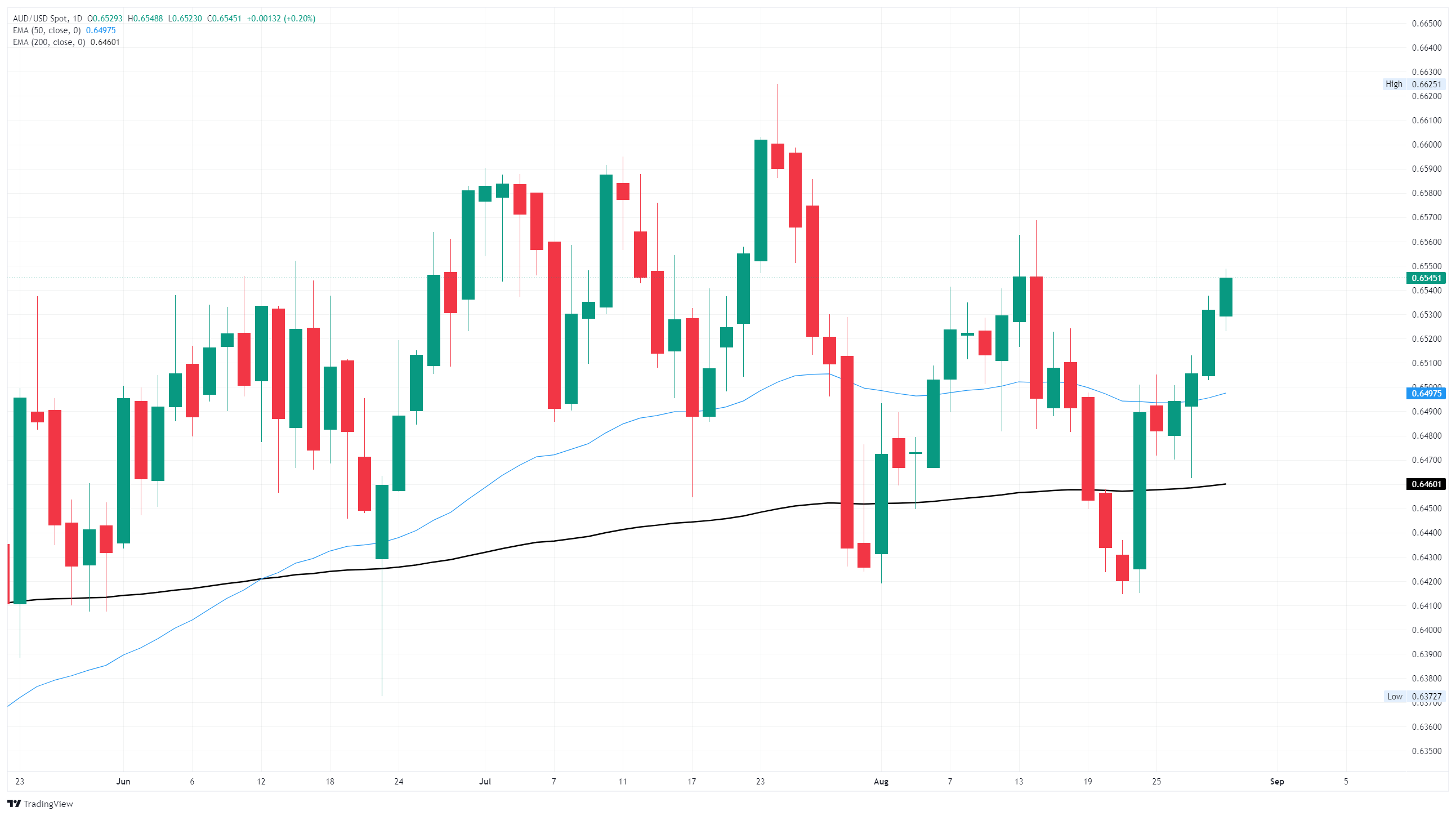
- AUD/USD gained ground for a fourth straight session on Friday.
- The Aussie is gaining ground on a slumping US Dollar as Fed rate cut hopes remain.
- Markets largely shrugged off another uptick in US PCE inflation.
AUD/USD caught a late-week lift on Friday, rising into the 0.6550 region after the latest US inflation data pushed the US Dollar (USD) lower across the board. The Australian Dollar (AUD) stepped into its fourth straight winning session against the Greenback, putting AUD/USD on a collision course with the top end of a technical range that has kept the pair constrained through most of the year.
US inflation pressures continue to rise
US Personal Consumption Expenditures Price Index (PCE) inflation rose again through the year ended in June, bringing core PCE to 2.9% YoY, marking a third straight month that key US inflation metrics have moved further away from, or at least failed to make any progress towards, the Federal Reserve’s (Fed) desired inflation target of 2%.
Despite fresh inflation pressures cooking away in the background, market bets for a Fed rate cut in September are still riding high, with rate traders pricing in nearly 90% odds of a rate trim on September 17. The latest round of US employment figures, due late next week, could be the final paving stone on the road to a Fed rate cut next month.
AUD/USD price forecast
The Aussie’s latest technical recovery has seen AUD/USD climb a little over 2% bottom-to-top from its last swing low into 0.6415, gaining ground for five of the last seven straight sessions. Despite a firmly bullish performance in the near-term, the pair is still trapped in the middle of a long-run consolidation pattern between 0.6400 and 0.6600.
Lacking any meaningful shifts in long-term sentiment, AUD/USD should be expected to continue cycling the 200-day Exponential Moving Average (EMA) near 0.6480 for the foreseeable future.
AUD/USD daily chart

Australian Dollar FAQs
One of the most significant factors for the Australian Dollar (AUD) is the level of interest rates set by the Reserve Bank of Australia (RBA). Because Australia is a resource-rich country another key driver is the price of its biggest export, Iron Ore. The health of the Chinese economy, its largest trading partner, is a factor, as well as inflation in Australia, its growth rate and Trade Balance. Market sentiment – whether investors are taking on more risky assets (risk-on) or seeking safe-havens (risk-off) – is also a factor, with risk-on positive for AUD.
The Reserve Bank of Australia (RBA) influences the Australian Dollar (AUD) by setting the level of interest rates that Australian banks can lend to each other. This influences the level of interest rates in the economy as a whole. The main goal of the RBA is to maintain a stable inflation rate of 2-3% by adjusting interest rates up or down. Relatively high interest rates compared to other major central banks support the AUD, and the opposite for relatively low. The RBA can also use quantitative easing and tightening to influence credit conditions, with the former AUD-negative and the latter AUD-positive.
China is Australia’s largest trading partner so the health of the Chinese economy is a major influence on the value of the Australian Dollar (AUD). When the Chinese economy is doing well it purchases more raw materials, goods and services from Australia, lifting demand for the AUD, and pushing up its value. The opposite is the case when the Chinese economy is not growing as fast as expected. Positive or negative surprises in Chinese growth data, therefore, often have a direct impact on the Australian Dollar and its pairs.
Iron Ore is Australia’s largest export, accounting for $118 billion a year according to data from 2021, with China as its primary destination. The price of Iron Ore, therefore, can be a driver of the Australian Dollar. Generally, if the price of Iron Ore rises, AUD also goes up, as aggregate demand for the currency increases. The opposite is the case if the price of Iron Ore falls. Higher Iron Ore prices also tend to result in a greater likelihood of a positive Trade Balance for Australia, which is also positive of the AUD.
The Trade Balance, which is the difference between what a country earns from its exports versus what it pays for its imports, is another factor that can influence the value of the Australian Dollar. If Australia produces highly sought after exports, then its currency will gain in value purely from the surplus demand created from foreign buyers seeking to purchase its exports versus what it spends to purchase imports. Therefore, a positive net Trade Balance strengthens the AUD, with the opposite effect if the Trade Balance is negative.
Information on these pages contains forward-looking statements that involve risks and uncertainties. Markets and instruments profiled on this page are for informational purposes only and should not in any way come across as a recommendation to buy or sell in these assets. You should do your own thorough research before making any investment decisions. FXStreet does not in any way guarantee that this information is free from mistakes, errors, or material misstatements. It also does not guarantee that this information is of a timely nature. Investing in Open Markets involves a great deal of risk, including the loss of all or a portion of your investment, as well as emotional distress. All risks, losses and costs associated with investing, including total loss of principal, are your responsibility. The views and opinions expressed in this article are those of the authors and do not necessarily reflect the official policy or position of FXStreet nor its advertisers. The author will not be held responsible for information that is found at the end of links posted on this page.
If not otherwise explicitly mentioned in the body of the article, at the time of writing, the author has no position in any stock mentioned in this article and no business relationship with any company mentioned. The author has not received compensation for writing this article, other than from FXStreet.
FXStreet and the author do not provide personalized recommendations. The author makes no representations as to the accuracy, completeness, or suitability of this information. FXStreet and the author will not be liable for any errors, omissions or any losses, injuries or damages arising from this information and its display or use. Errors and omissions excepted.
The author and FXStreet are not registered investment advisors and nothing in this article is intended to be investment advice.